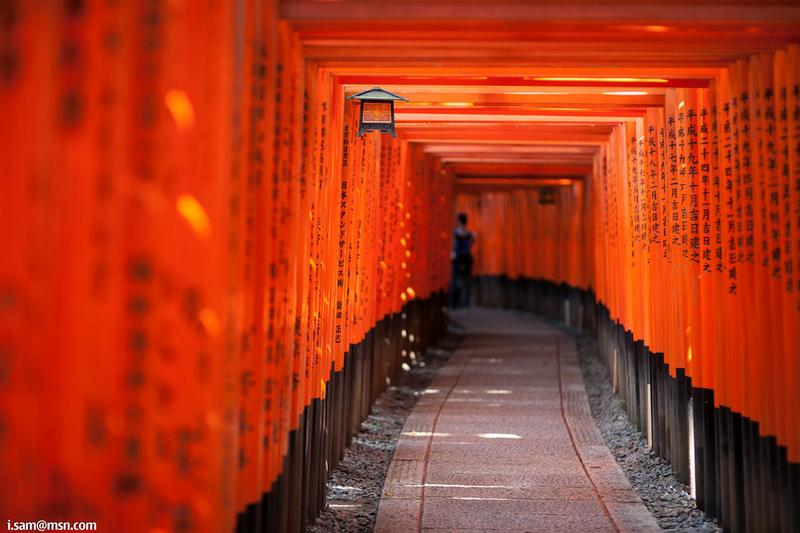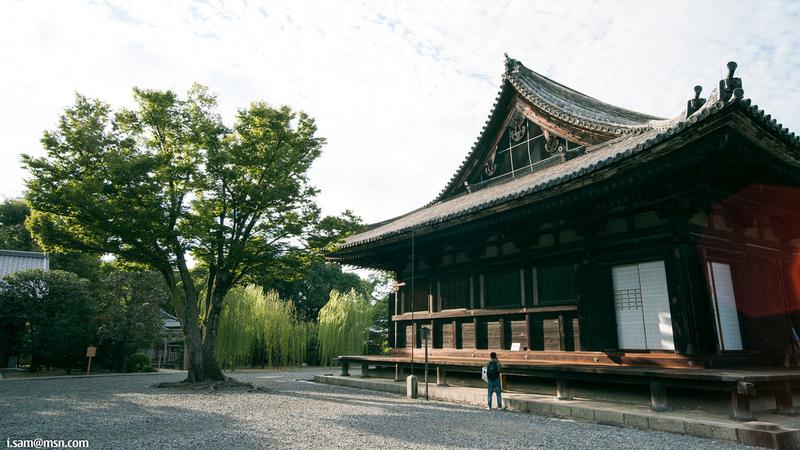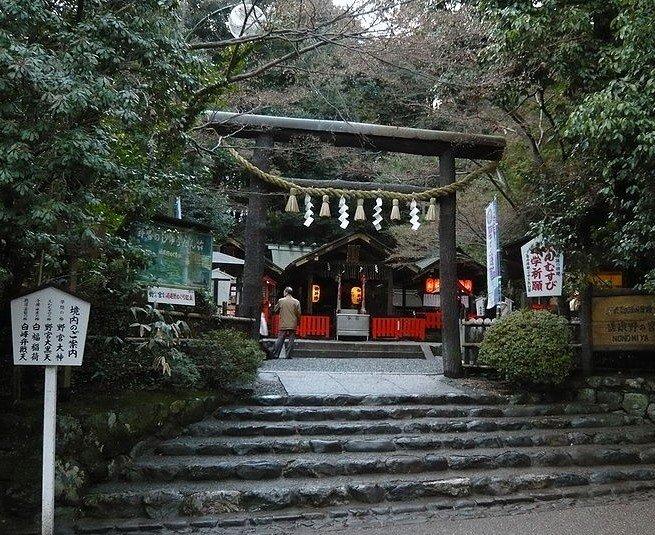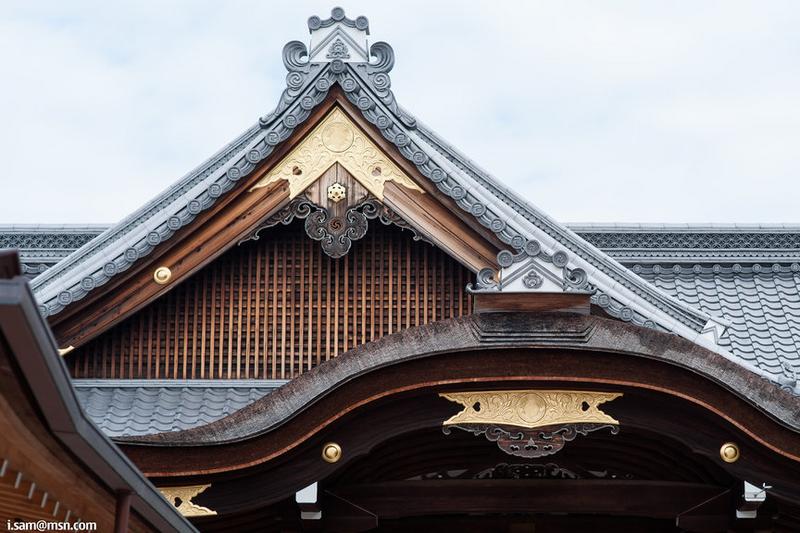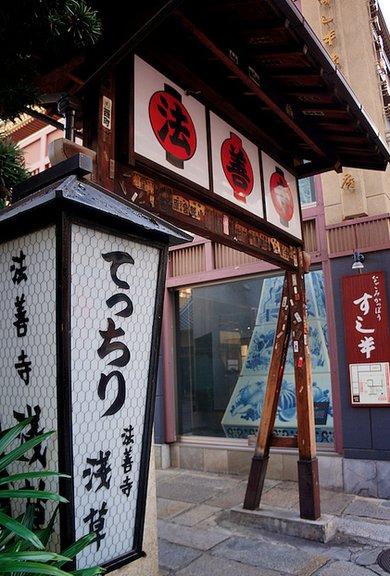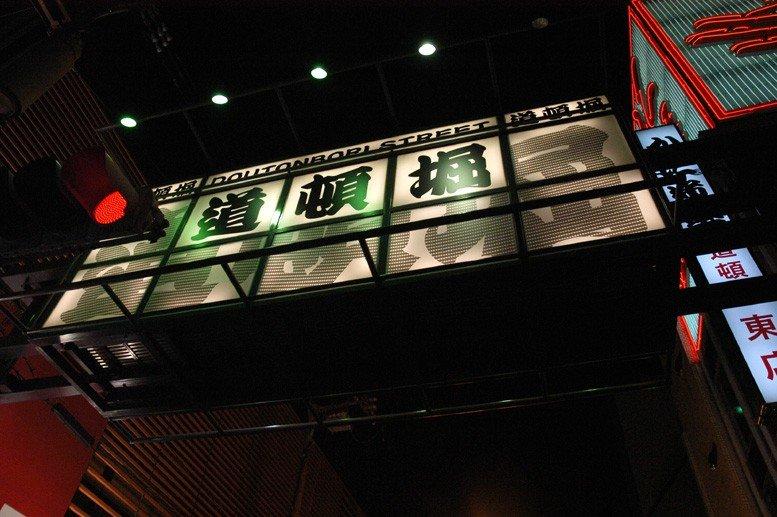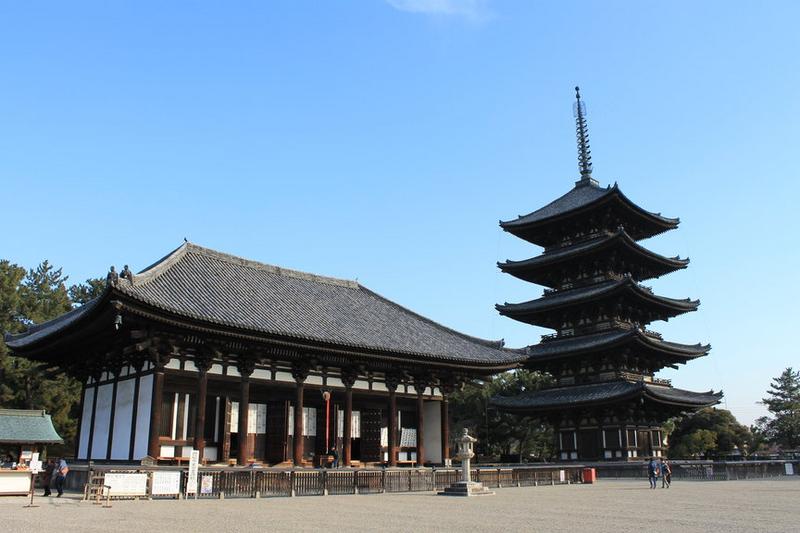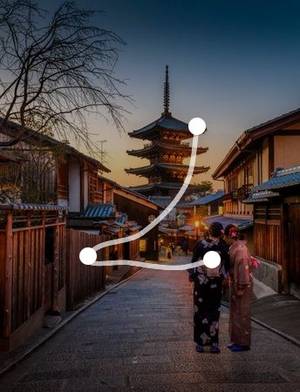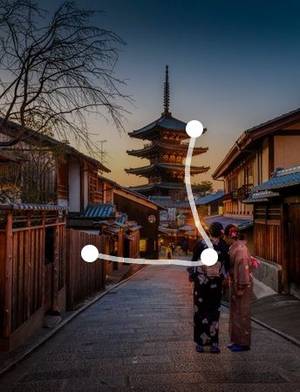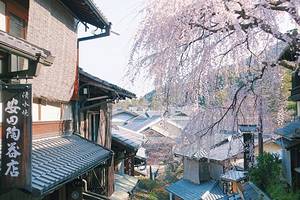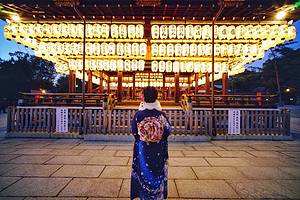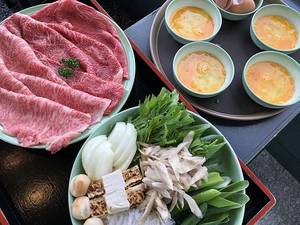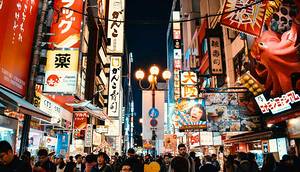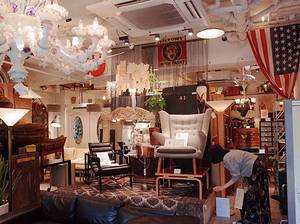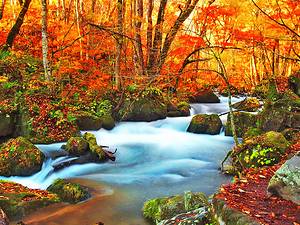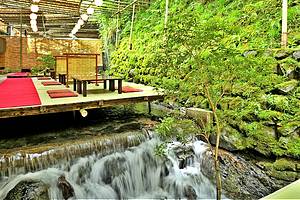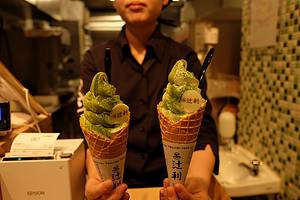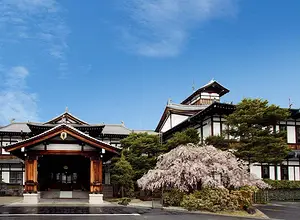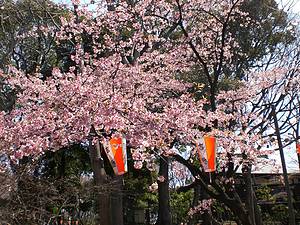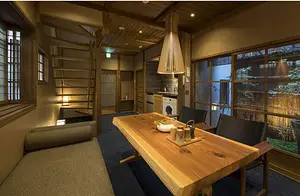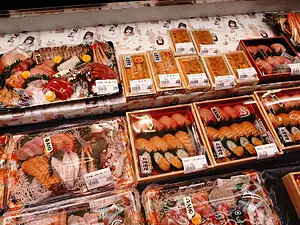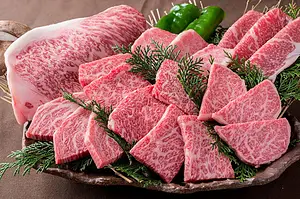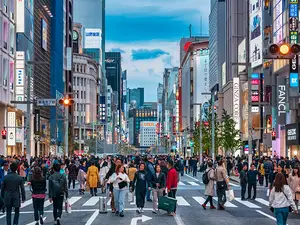7-day tour of Kyoto, Osaka, and Nara in Kansai
3 cities |
25 attraction(s) |
total distance 40
km
 TIPS
TIPS
Day1
Day2
Day3
Day4
Day5
Day6
Day7
Day1: Kyoto
4 attraction(s) ·
9 km
1
Located at the foot of Mount Inari in the southern part of Kyoto, it has a long history. The deity Inari, who blesses business prosperity and bountiful harvests in agriculture, is enshrined here, attracting many visitors. Foxes are considered messengers of the gods, so there are various fox statues and ema (prayer plaques) in the shape of fox faces. In addition to the main shrine, Fushimi Inari Taisha is famous for its "Senbon Torii" (thousands of torii gates). Hundreds and thousands of vermilion torii gates form a pathway to the mountaintop, spanning approximately 4 kilometers. It takes about 2-3 hours to walk the entire route. This path is one of the iconic landscapes of Kyoto and has been featured in the movie "Memoirs of a Geisha."
3
km
2
Sanjusangendo, also known as Rengeo-in, is located in the eastern part of Kyoto. It houses Buddhist statues and cultural treasures that are designated as national treasures of Japan, particularly renowned for the 1001 statues of the Thousand-Armed, Thousand-Eyed Kannon and the Twenty-Eight Deity Standing Images. The main hall, which enshrines the Kannon statue, is one of Japan's longest wooden structures.
4
km
3
Pontocho is a Hanamachi (geisha district) located between the Kamogawa River and Kiyamachi-dori in Nakagyo-ku, Kyoto City. Originally a sandbar in the Kamogawa River, it was reclaimed through embankment work in the early Edo period and was called Shinkawaramachi-dori. It later developed into a bustling street with tea houses and inns, and after the establishment of licensed geisha, it became a famous Hanamachi. In addition to the unique commercial establishments of the Hanamachi, there are also general restaurants, and many of the restaurants on the east side facing the Kamogawa River have seating areas for summer coolness.
2
km
4
There are two rivers in the city, flowing from north to south. They merge into a Y shape, with the left branch called Hema River and the right branch called Gaohe River. The merged part is still pronounced the same as Hema River, but written as "Yachen" in Chinese characters. People often come and go here, and it's suitable for taking a casual walk along the riverbank, especially at night when the scenery is better. There are various restaurants on both sides of the riverbank, but they can be quite expensive.
Day2: Kyoto
6 attraction(s) ·
4 km
1
Kiyomizu-dera Temple was founded in 778, earlier than the establishment of Kyoto as a capital city. It is a temple with a long history located on the slopes of Mt. Otawa in the eastern part of Kyoto. The current buildings, mostly dating back to the early Edo period (1631-1633), were reconstructed by the third shogun, Tokugawa Iemitsu. The main hall of the temple is designated as a national treasure, and it also possesses important cultural properties such as the Niomon Gate, the West Gate, the three-storied pagoda, and the bell tower. In 1994, Kiyomizu-dera Temple was listed as one of the UNESCO World Heritage Sites under the designation "Historic Monuments of Ancient Kyoto."
The famous "Kiyomizu stage" is supported by numerous giant keyaki (zelkova) pillars, approximately 12 meters high, arranged side by side. It is constructed using the "suspended structure" technique without the use of a single nail. The floor is covered with over 410 cypress boards, creating a large wooden structure that extends from the main hall to the edge of the cliff, offering a magnificent view of Kyoto.
Inside the temple, there are three streams of the Otawa Waterfall, representing longevity, success in academics, and fulfillment of love. When making a prayer, one can only choose one of the streams to drink from and take only a sip. Otherwise, the wish will not come true.
Outside the main temple, there are several other structures, including the three-storied pagoda and the Zuigu-do Hall. By purchasing a 100 yen ticket, visitors can enter the basement of Zuigu-do Hall and experience the famous "womb walk," symbolizing prayer inside the Buddha's womb. Additionally, Kiyomizu-dera Temple opens for night visits at specific times throughout the year.
The "Otawa Waterfall" from which Kiyomizu-dera Temple derives its name has been quietly flowing since the temple's establishment. Within the lush temple grounds, 15 colorful halls and towers are scattered. The beauty of Kiyomizu-dera Temple, reflecting the cherry blossoms, fresh greenery, and autumn leaves, is widely known as a representative scenery of Kyoto.
The annual "Kanji of the Year" event, which has been held since 1995, is announced at Kiyomizu-dera Temple in December. The Kyoto Kanji Association also considers Kiyomizu-dera Temple to be a typical representative of Japanese temples.
1
km
2
Ninenzaka
The Eiin-zaka Slope was built in 807 AD and provides a direct route from the Sanneizaka Slope to the Ninen-zaka Slope, connecting Kiyomizu-dera Temple and Kodai-ji Temple. Eiin-zaka and Sanneizaka are famous neighborhoods in Kyoto, characterized by old wooden houses and traditional Japanese shops.
1
km
3
The Stone Paved Path is a narrow and winding path that intersects perpendicularly with the Ningning Road. It is peaceful, full of twists and turns, and highly secluded, housing several high-end restaurants. In the spring nights, there is also a "Flower Lantern Road" event.
2
km
4
Hanami Koji is a north-south street in the Higashiyama district of Kyoto. The most famous part is the section that extends north from Kennin-ji Temple, which is a historic street with the famous Kaburenjo Theater. In spring and autumn, there are grand dance performances by Kabuki actors and geishas. The street is filled with traditional Kyoto-style buildings, and recently, Leica and Hermès have opened unique experiential stores here. It should be noted that Hanami Koji is often crowded with people and vehicles, so attention to safety is necessary when taking photos.
1
km
5
Yasaka Shrine is a shrine located in Higashiyama Ward, Kyoto City, Kyoto Prefecture, Japan. It is one of the twenty-two shrines and serves as the head shrine for approximately three thousand Yasaka Shrines throughout Japan. It is commonly known as Gion-san. The shrine's regular festival is called the Gion Festival and, along with Tokyo's Kanda Festival and Osaka's Tenjin Festival, is known as one of the three major festivals in Japan. Originally known as "Gion Shrine," "Gion Society," "Gion Kanjinin," and "Hie Shrine," it was renamed "Yasaka Shrine" after the separation of Shinto and Buddhism in the fourth year of Keio (1868).
1
km
6
Gion Corner is a theater that showcases traditional Kyoto performing arts. Each performance lasts about an hour and includes various forms of art such as Kyoto-style dance, flower arrangement, tea ceremony, koto music, classical Japanese music, kyogen comedy, and bunraku puppetry, allowing visitors to experience Kyoto's culture in one show. Additionally, there is a Kabuki corridor displaying video materials and Kabuki hairpins.
Day3: Kyoto
4 attraction(s) ·
6 km
1
Arashiyama is located west of Kyoto city and has been a popular residential and leisure destination for nobles since the Heian period. Along the banks of the Katsura River, there are extensive cherry blossom and maple forests, and the Bamboo Grove Path in Arashiyama is also popular among tourists. Whether it's enjoying cherry blossoms in spring, autumn foliage, or simply strolling through the bamboo grove, you can experience the beauty of Kyoto's scenery. The Arashiyama area is also home to many famous temples and shrines, and its landscapes often appear in Japanese historical stories and classical literary works. Arashiyama also has hot springs where you can enjoy the pleasure of bathing.
2
km
2
Appeared in the classical literary masterpiece "The Tale of Genji." The Kuroki Bird Gate is its symbol, and the moss garden in the shrine is beautiful. The paintings and amulets both have a strong Genji Monogatari style and can be bought as souvenirs.
3
km
3
Tenryu-ji Temple is a temple located in Sagano Tenryu-ji, Sagano, Ukyo-ku, Kyoto City, Kyoto Prefecture, Japan. It is the head temple of the Tenryu-ji branch of the Rinzai sect of Zen Buddhism. Its mountain name is "Reigizan." The main deity is Shakyamuni Buddha. The founder is Ashikaga Takauji, and the first abbot is Muso Soseki. Initially, it was established by Ashikaga Takauji to appease the spirit of Emperor Go-Daigo. The temple is of significant size and ranks first among the Five Mountains of Kyoto. In addition to being designated as a special historic site by Japan, it was also inscribed on the UNESCO World Heritage List as part of the "Historic Monuments of Ancient Kyoto" in December 1994.
2
km
4
Togetsukyo Bridge is located in Kyoto City, Kyoto Prefecture. It is a bridge that spans the Katsura River and is used by both vehicles and pedestrians. The northern side of the bridge belongs to the Sagano area in Ukyo Ward, while the southern side, Arashiyama, is part of Nishikyo Ward. If you cross Togetsukyo Bridge from the north, you will reach the foot of Arashiyama after passing through Nakano Island (Sagano Nakano Island Town). The Arashiyama area surrounding Togetsukyo Bridge is a popular destination for cherry blossom and autumn foliage viewing in the western outskirts of Kyoto. As a result, severe traffic congestion often occurs during the peak tourist season.
Day4: Kyoto
3 attraction(s) ·
7 km
1
The formal name is Rokuon-ji Temple. The Golden Pavilion, built in 1397, was originally a villa belonging to Ashikaga Yoshimitsu, a shogun. It was later converted into a Zen temple. The name "Golden Pavilion" comes from the reliquary hall covered in gold leaf where Yoshimitsu practiced Zen. The temple became known as the Golden Pavilion due to the gold leaf exterior, and it was intentionally set on fire in 1950. The current golden building is a restoration. Those interested in this history can read Yukio Mishima's novel "The Temple of the Golden Pavilion."
The Golden Pavilion is a three-story structure. The first floor is called Hojo, the second floor is called Chōon-dō and enshrines the bodhisattva Kannon, and the third floor is a square-shaped Buddha hall housing three statues of Amida Buddha. The architecture of the Golden Pavilion integrates with the surrounding garden, and the picturesque reflection of the golden pavilion in the clear waters of Mirror Pond is a representative sight in Kyoto.
Unique aspects of the Golden Pavilion: Visitors receive a red seal stamp with a blessing instead of an admission ticket. Additionally, next to the Kinkaku-ji temple, there are Chinese and Korean divination sticks available for fortune-telling, and the matcha ice cream sold within the temple has a good reputation.
2
km
2
Ryoanji Temple is a Zen Buddhist temple located in Ukyo Ward, Kyoto City, Kyoto Prefecture, Japan. It is renowned for its stone garden. The mountain name is Daiunzan. Ryoanji Temple was established in the 2nd year of Hoji (1450). The main deity is Shakyamuni Buddha, and it was founded by Hosokawa Katsumoto. The first abbot was Yiten Gencho. It is recognized as a part of the cultural heritage of Kyoto, the ancient capital, and is listed as a World Heritage Site. During Queen Elizabeth II's visit to Japan in 1975, she expressed her desire to visit the garden of Ryoanji Temple. After her visit, the Queen praised the garden, bringing worldwide fame to the Ryoanji Temple garden. Experts have studied the hidden structure in the garden, which is designed to attract viewers' unconscious visual sensitivity. Ryoanji Temple's stone garden is considered one of Japan's most famous examples of a dry landscape garden.
5
km
3
Built by the first shogun of the Edo Shogunate, Tokugawa Ieyasu, and returned to the imperial court by the last shogun, Tokugawa Yoshinobu, this is one of the world cultural heritages in Kyoto, preserving the painting, carving, and architectural features of the Momoyama Period in Japan. The Honmaru in Nijo Castle is an important cultural heritage, and the Ninomaru Palace is a national treasure. The palace includes rooms for receiving daimyo (feudal lords) and court officials, as well as living quarters. The Ninomaru Garden and Seiryu-en Garden in Nijo Castle are also famous gardens. Nijo Castle provides multilingual audio guides in Chinese, English, Korean, and Japanese, which can be requested at the Higashi-Ote-Mon Gate.
The Ninomaru Palace is decorated with luxurious painted screens and carvings, embodying the beauty of that time. The Ninomaru Garden outside the palace is a traditional Japanese garden with ponds, decorative stones, and neatly trimmed pine trees. There is also a corridor called "Uguisubari" in Nijo Castle, where walking produces the chirping sound of a nightingale, serving as an alarm system against assassins, set up by the rulers. The Honmaru is usually not open to the public, but visitors can enter the Honmaru Garden for sightseeing.
There is a belief that the underground passage of Nijo Castle leads to Chion-in Temple, as it is said that Tokugawa Ieyasu, for safety reasons, designated Chion-in Temple as a backup location. Therefore, Chion-in Temple has received protection from the successive heads of the Tokugawa family.
Nijo Castle is not only a famous cherry blossom viewing spot in spring, but it also showcases beautiful autumn colors with maple and ginkgo trees. Moreover, there are pedestrian streets, shops, and other leisure facilities where visitors can buy local specialties or take a break while sightseeing.
Day5: Osaka
4 attraction(s) ·
12 km
1
Osaka Castle Park Center
Osaka Castle Park is a vast park. From late January to early March, the plum blossoms in the park's plum grove bloom, attracting numerous visitors. From late March to early April, over 4,000 cherry blossom trees bloom, making it a popular cherry blossom viewing spot in Osaka.
Osaka Castle, known as one of Japan's three famous castles, was built by Toyotomi Hideyoshi with the goal of unifying the country, taking three years to complete. Although it was burned down multiple times during wars, it was rebuilt in 1931 with the efforts of the people of Osaka and has stood ever since. It is one of Osaka's most iconic buildings. The grand Osaka Castle Keep has a five-story exterior and an eight-story interior. Its dazzling gold-plated reliefs earned it the nicknames "Golden Castle" or "Castle of Brocade." When taking photos of the castle keep, don't miss the golden carp on the top. The lower seven floors of the keep are used for exhibiting historical artifacts, and the eighth floor observation deck offers a panoramic view of Osaka's cityscape. As a representative historical building in Osaka, Osaka Castle has appeared in numerous movies, TV shows, anime, and games, making it a must-visit location for travelers in Osaka.
There are two shops near the castle keep that serve delicious takoyaki (octopus balls) at affordable prices. It is recommended to try them. The Osaka Museum of History, Osaka City Museum, Osaka Prefectural Police Headquarters, Osaka Castle Hall, and Osaka NHK Hall, located near the park, are also worth visiting or photographing from the outside.
6
km
2
Hozenji Temple is located in the shopping street of Namba, Osaka. It is also known as Sen Nichi Temple because people used to chant Buddhist scriptures continuously for a thousand days there. The name "Sen Nichi" is derived from this practice. The main purpose of Hozenji Temple is to pray for successful relationships and prosperous business. Situated in the lively and bustling Dotonbori area, it is not only popular among locals but also attracts many foreign travelers. The most famous feature of Hozenji Temple is the Mizukake Fudo, or the "Unmoving Water Hanging Statue." This Buddha statue is made from natural tree materials and is covered in leaves and moss. Visitors who come to worship first pour water over the statue, which makes it unique. During the air raids in Osaka, the entire temple was burned down, but miraculously, the Unmoving Water Hanging Statue survived. Combined with the temple's reputation for granting prayers, it continues to attract a steady stream of visitors every day.
1
km
3
Dotonbori is the most bustling area in Osaka, a landmark food destination and the birthplace of Osaka's culinary culture. It is a top choice for travelers visiting Osaka, offering a wide range of specialty foods such as takoyaki, teppanyaki, yakitori, conveyor belt sushi, fugu cuisine, and various delightful desserts. Even inconspicuous small shops can satisfy your taste buds. This reflects the food culture that the people of Osaka aspire to, where it's not uncommon to eat until bankruptcy.
If I have to make a special recommendation, you can try the always crowded "Kinryu Ramen" right at the entrance, the original teppanyaki restaurant "Boteyu," and the famous takoyaki shop "Konamon Museum" where you can also experience making takoyaki. There's also the flagship stores of "Osaka Ohsho" and "Kani Doraku." When you come to Osaka, how can you miss the opportunity to taste the most authentic flavors from these two nationally renowned establishments? In addition to savoring delicious food, you can visit the Hōzen-ji Temple to pay respects to the deity Fudō Myō-ō, watch Kabuki performances at the Shochikuza theater, and take a stroll along the Dotonbori River at night, enjoying the vibrant neon lights on both sides and experiencing the unique ambiance of the Edo period in the Hōzen-ji Yokocho alley.
6
km
4
Floating Garden
The Sky Garden Observatory charges admission and offers beautiful views of various areas of Osaka city center with Umeda as the focal point, which is popular among tourists.
Day6: Nara
3 attraction(s) ·
5 km
1
In the year 669 AD (8th year of the Tenji era), Tachibana-no-kami no kurozuka's wife, Kagitokimi no ōkimi, built Sanjō-ji Temple in her private residence to pray for her husband's recovery. The temple housed three statues of Shakyamuni, to whom Kurozuka had made vows. Several years later, Sanjō-ji Temple was relocated to Uzusaka in Nara Prefecture and became known as Uzusaka-dera.
In 710 AD, the capital was moved to Nara, and Sanjō-ji Temple was also relocated to its present site and renamed Kōfuku-ji Temple. With the support of the emperor and the Fujiwara clan, the temple flourished and became one of the four great temples of the Nara period and one of the seven great temples of the Heian period, thanks to its close ties to the Sesonji family (Fujiwara Hokke).
During the Heian period, the true ruling power was held by Kasuga Taisha Shrine. However, Kōfuku-ji Temple controlled Kasuga Taisha Shrine and became the true ruler of Yamato Province. In the Kamakura period (1185-1333) and Muromachi period (1336-1573), the shogunate appointed Kōfuku-ji Temple as the guardian of Yamato Province, but gradually reduced its financial support. In the late Muromachi period, Kōfuku-ji Temple suffered a significant decline in resources. In the Edo period, Tokugawa Ieyasu (1543-1616) provided an annual salary of 21,000 koku to the temple, which restored its support.
In the early Meiji period, the Shinto-Buddhist separation order was issued, leading to an anti-Buddhist movement that resulted in Kōfuku-ji Temple's separation from Kasuga Taisha Shrine. Many of the temple's properties were confiscated, severely impacting the temple. Despite subsequent hardships, Kōfuku-ji Temple eventually recovered and remains one of the major temples of the Hossō sect.
Kōfuku-ji Temple is a temple located in Nara City, Nara Prefecture, Japan. It is the head temple of the Hossō sect, one of the six sects of Nanto. Originally built in 730 AD, its five-story pagoda stands at a height of 50.8 meters. The pagoda has experienced several reconstructions, with the current one being built in 1426 AD. It is also one of the seven great temples of Nanto. Inclusion in UNESCO's World Heritage List was granted as part of "Historic Monuments of Ancient Nara."
Due to a large-scale seismic repair project, the National Treasure Gallery will be closed from January 1, 2017 to December 31, 2017. However, the temporary main hall of Kōfuku-ji Temple will be open to allow visitors to see major national treasures such as the Asura statue, the Eight Legions, the Ten Great Disciples, the Vajrapani, and the Hara-koto during special openings from March 15 to June 18 and September 15 to November 19, 2017. Further details will be announced later.
Additionally, the National Treasure Gallery will be temporarily closed from July 19 to July 22, 2016, for exhibit replacement. We apologize for any inconvenience caused.
Please note the following annual events:
- Setsubun Festival on February 2: Reconstruction Meeting (Tōkeidō)
- Nirvana Memorial Service on February 15 (Honbō)
- Sankashiki Ceremony on March 5 (Honbō)
- Buddha's Birth Festival on April 8 (Nanden-dō)
- Animal Release Ceremony on April 17 (Ichigon Kannon-dō)
- Monju Festival on April 25 (Tōkeidō)
- Shingon Fire Ritual on the third Friday and Saturday in May (Minami Daimonji)
- Benzaiten Offering on July 7 (Sanjū no tō)
- Daihannya Sutra Reading Ceremony on October 17 (Minami Enjōdō)
- Jionin Prayer Meeting on November 13 (Temporary Kondō, North of Chūkondō)
Every second Saturday of the month, experts knowledgeable in Buddhism and Buddhist art are invited to give lectures at the Kōfuku-ji Temple Hall, free of charge and open to all participants. (Lectures will be conducted in Japanese.)
2
km
2
Nara Park is located on the east side of Nara City, with many famous historical sites such as Mount Wakakusa, Todaiji Temple, Kasuga Grand Shrine, and the National Museum. The park is known for its playful deer, which are designated as national natural treasures. The spring blossoms and autumn maple leaves in the park are delightful, while the off-season offers a leisurely atmosphere for strolling. Nara Park has captivating scenery throughout the year.
3
km
3
Nara-machi is the oldest town in Nara, located in the alley next to Sarusawa Pond. The wooden lattice-window buildings from the Edo period, which were built a hundred years ago, stand side by side. The old streets also hide many coffee shops or tea houses with quaint exteriors and stylish interiors. Gango-ji Temple, also listed as a World Heritage site, is also located in Nara-machi.
Day7: Osaka
1 attraction(s) ·
0 km
1
Universal Studios Japan, also known as USJ, is a highly popular theme park in Japan, similar to Tokyo Disneyland. It is a must-visit attraction for both Japanese citizens and foreign travelers when visiting the Kansai region. After enjoying the beautiful scenery of Osaka, you can experience a different kind of excitement and joy at Universal Studios, where various entertaining facilities with Hollywood movie themes await you.
Here, you can watch Spider-Man swinging through the city, dodge encounters with sharks at sea, marvel at the roaming dinosaurs in Jurassic Park, and feel the danger of being chased by zombies in the world of Resident Evil. The water world show, which only performs once a day, offers an immersive experience filled with excitement and spectacle. Don't miss out on the thrilling experience of riding a roller coaster backward, personally tested by members of the popular Japanese idol group SMAP. The park also features various interesting themed restaurants and dazzling parade performances at night. The wonders and delights of Universal Studios don't need much introduction – come and experience it firsthand, as it will definitely be worth your visit.
Since its grand opening in July 2014, the highly popular Harry Potter-themed area faithfully recreates the scenes from the original work and offers a wide range of exquisite merchandise for sale.
Due to its convenient transportation and proximity to Osaka Station, as well as shorter queue times for attractions compared to Disneyland, visiting Universal Studios is a relatively relaxed experience in terms of time management. Additionally, the park's opening and closing times vary, so travelers who want to see the nighttime parade should remember to check the official website in advance for the schedule.
Useful tip: UnionPay cards starting with "62" are accepted within the park. More than half of the local ATMs also allow cash withdrawals using UnionPay cards, and most ATMs have user-friendly interfaces in Chinese.
